KIA Optima 2006 2.G Manual Online
Manufacturer: KIA, Model Year: 2006, Model line: Optima, Model: KIA Optima 2006 2.GPages: 225, PDF Size: 3.77 MB
Page 81 of 225
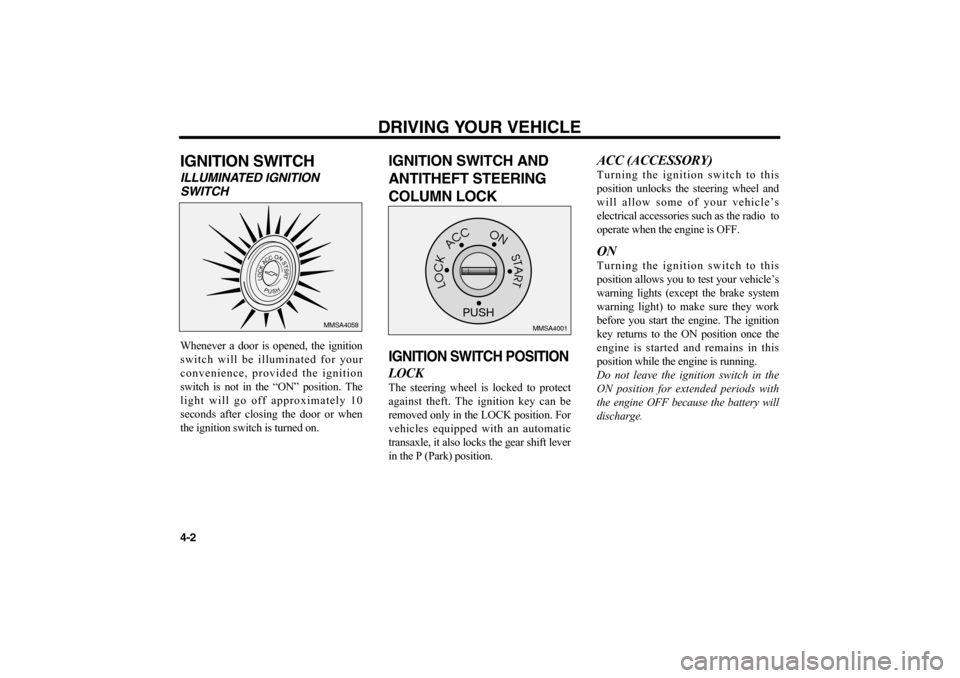
IGNITION SWITCH ILLUMINATED IGNITION
SWITCHWhenever a door is opened, the ignition
switch will be illuminated for your
convenience, provided the ignition
switch is not in the “ON” position. The
light will go off approximately 10
seconds after closing the door or when
the ignition switch is turned on.
IGNITION SWITCH AND
ANTITHEFT STEERING
COLUMN LOCK IGNITION SWITCH POSITIONLOCKThe steering wheel is locked to protect
against theft. The ignition key can be
removed only in the LOCK position. For
vehicles equipped with an automatic
transaxle, it also locks the gear shift lever
in the P (Park) position.
ACC (ACCESSORY)Turning the ignition switch to this
position unlocks the steering wheel and
will allow some of your vehicle’s
electrical accessories such as the radio to
operate when the engine is OFF.ONTurning the ignition switch to this
position allows you to test your vehicle’s
warning lights (except the brake system
warning light) to make sure they work
before you start the engine. The ignition
key returns to the ON position once the
engine is started and remains in this
position while the engine is running.
Do not leave the ignition switch in the
ON position for extended periods with
the engine OFF because the battery will
discharge.
DRIVING YOUR VEHICLE
4-2
PUSH
LOCKACCONSTSRT
MMSA4058
PUSH
MMSA4001
MS-CNA-Eng 4(~39).QXD 7/25/2005 5:16 PM Page 2
Page 82 of 225
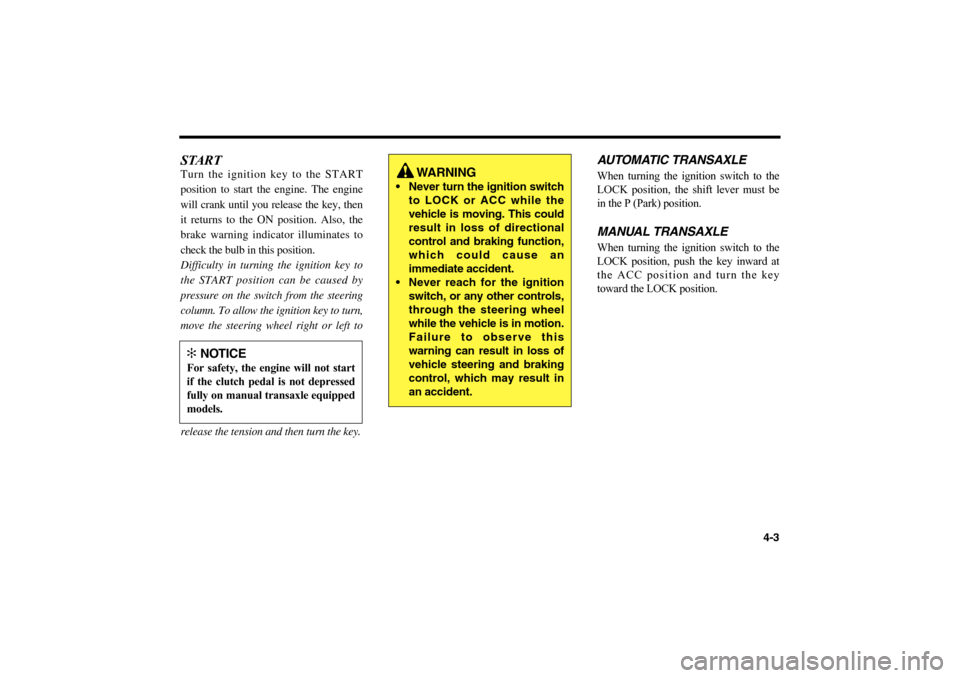
STARTTurn the ignition key to the START
position to start the engine. The engine
will crank until you release the key, then
it returns to the ON position. Also, the
brake warning indicator illuminates to
check the bulb in this position.
Difficulty in turning the ignition key to
the START position can be caused by
pressure on the switch from the steering
column. To allow the ignition key to turn,
move the steering wheel right or left to
release the tension and then turn the key.
AUTOMATIC TRANSAXLEWhen turning the ignition switch to the
LOCK position, the shift lever must be
in the P (Park) position.MANUAL TRANSAXLEWhen turning the ignition switch to the
LOCK position, push the key inward at
the ACC position and turn the key
toward the LOCK position.
4-3
✻
NOTICE
For safety, the engine will not start
if the clutch pedal is not depressed
fully on manual transaxle equipped
models.
WARNING
• Never turn the ignition switch
to LOCK or ACC while the
vehicle is moving. This could
result in loss of directional
control and braking function,
which could cause an
immediate accident.
Never reach for the ignition
switch, or any other controls,
through the steering wheel
while the vehicle is in motion.
Failure to observe this
warning can result in loss of
vehicle steering and braking
control, which may result in
an accident.
MS-CNA-Eng 4(~39).QXD 7/25/2005 5:16 PM Page 3
Page 83 of 225
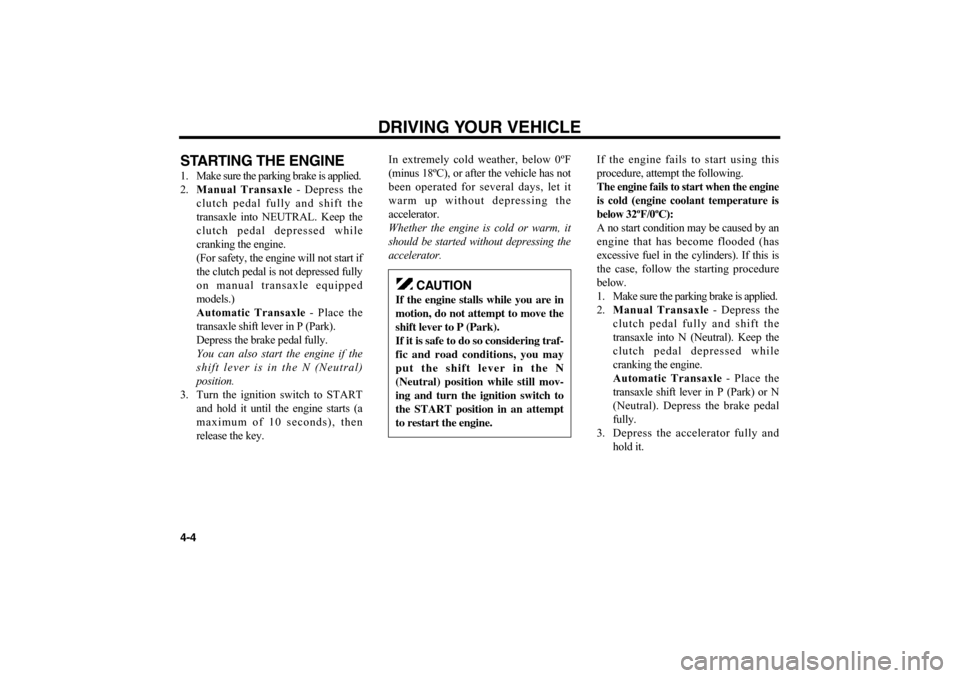
STARTING THE ENGINE1. Make sure the parking brake is applied.
2.Manual Transaxle- Depress the
clutch pedal fully and shift the
transaxle into NEUTRAL. Keep the
clutch pedal depressed while
cranking the engine.
(For safety, the engine will not start if
the clutch pedal is not depressed fully
on manual transaxle equipped
models.)
Automatic Transaxle- Place the
transaxle shift lever in P (Park).
Depress the brake pedal fully.
You can also start the engine if the
shift lever is in the N (Neutral)
position.
3. Turn the ignition switch to START
and hold it until the engine starts (a
maximum of 10 seconds), then
release the key.In extremely cold weather, below 0ºF
(minus 18ºC), or after the vehicle has not
been operated for several days, let it
warm up without depressing the
accelerator.
Whether the engine is cold or warm, it
should be started without depressing the
accelerator.If the engine fails to start using this
procedure, attempt the following.
The engine fails to start when the engine
is cold (engine coolant temperature is
below 32ºF/0ºC):
A no start condition may be caused by an
engine that has become flooded (has
excessive fuel in the cylinders). If this is
the case, follow the starting procedure
below.
1. Make sure the parking brake is applied.
2.Manual Transaxle- Depress the
clutch pedal fully and shift the
transaxle into N (Neutral). Keep the
clutch pedal depressed while
cranking the engine.
Automatic Transaxle- Place the
transaxle shift lever in P (Park) or N
(Neutral). Depress the brake pedal
fully.
3. Depress the accelerator fully and
hold it.
DRIVING YOUR VEHICLE
4-4
CAUTION
If the engine stalls while you are in
motion, do not attempt to move the
shift lever to P (Park).
If it is safe to do so considering traf-
fic and road conditions, you may
put the shift lever in the N
(Neutral) position while still mov-
ing and turn the ignition switch to
the START position in an attempt
to restart the engine.
MS-CNA-Eng 4(~39).QXD 7/25/2005 5:16 PM Page 4
Page 84 of 225
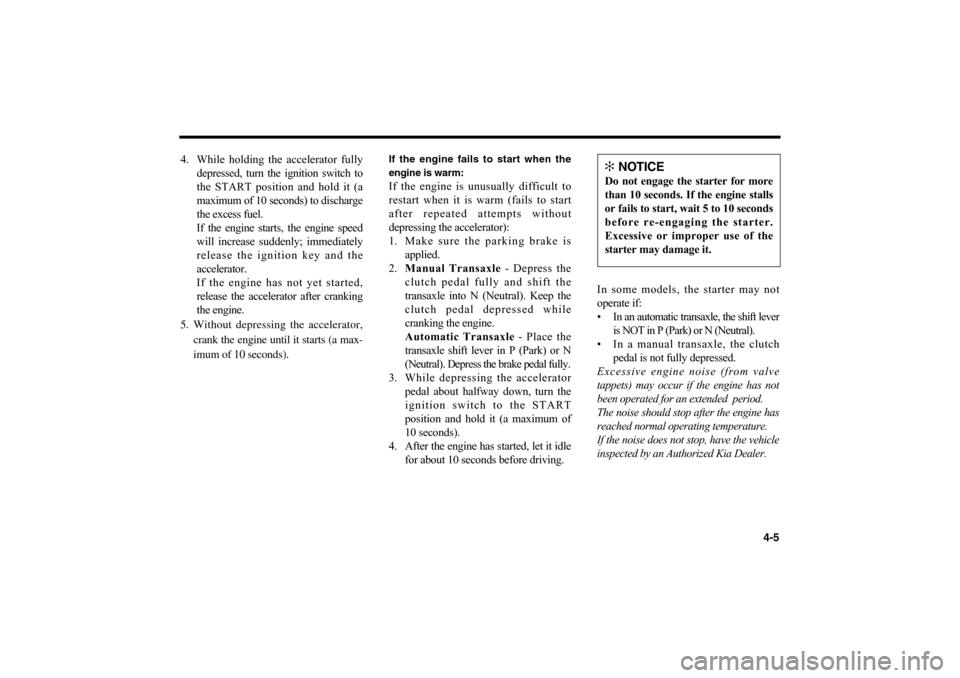
4. While holding the accelerator fully
depressed, turn the ignition switch to
the START position and hold it (a
maximum of 10 seconds) to discharge
the excess fuel.
If the engine starts, the engine speed
will increase suddenly; immediately
release the ignition key and the
accelerator.
If the engine has not yet started,
release the accelerator after cranking
the engine.
5. Without depressing the accelerator,
crank the engine until it starts (a max-
imum of 10 seconds).
If the engine fails to start when the
engine is warm:If the engine is unusually difficult to
restart when it is warm (fails to start
after repeated attempts without
depressing the accelerator):
1. Make sure the parking brake is
applied.
2.Manual Transaxle- Depress the
clutch pedal fully and shift the
transaxle into N (Neutral). Keep the
clutch pedal depressed while
cranking the engine.
Automatic Transaxle- Place the
transaxle shift lever in P (Park) or N
(Neutral). Depress the brake pedal fully.
3. While depressing the accelerator
pedal about halfway down, turn the
ignition switch to the START
position and hold it (a maximum of
10 seconds).
4. After the engine has started, let it idle
for about 10 seconds before driving.In some models, the starter may not
operate if:
• In an automatic transaxle, the shift lever
is NOT in P (Park) or N (Neutral).
• In a manual transaxle, the clutch
pedal is not fully depressed.
Excessive engine noise (from valve
tappets) may occur if the engine has not
been operated for an extended period.
The noise should stop after the engine has
reached normal operating temperature.
If the noise does not stop, have the vehicle
inspected by an Authorized Kia Dealer.
4-5
✻
NOTICE
Do not engage the starter for more
than 10 seconds. If the engine stalls
or fails to start, wait 5 to 10 seconds
before re-engaging the starter.
Excessive or improper use of the
starter may damage it.
MS-CNA-Eng 4(~39).QXD 7/25/2005 5:16 PM Page 5
Page 85 of 225
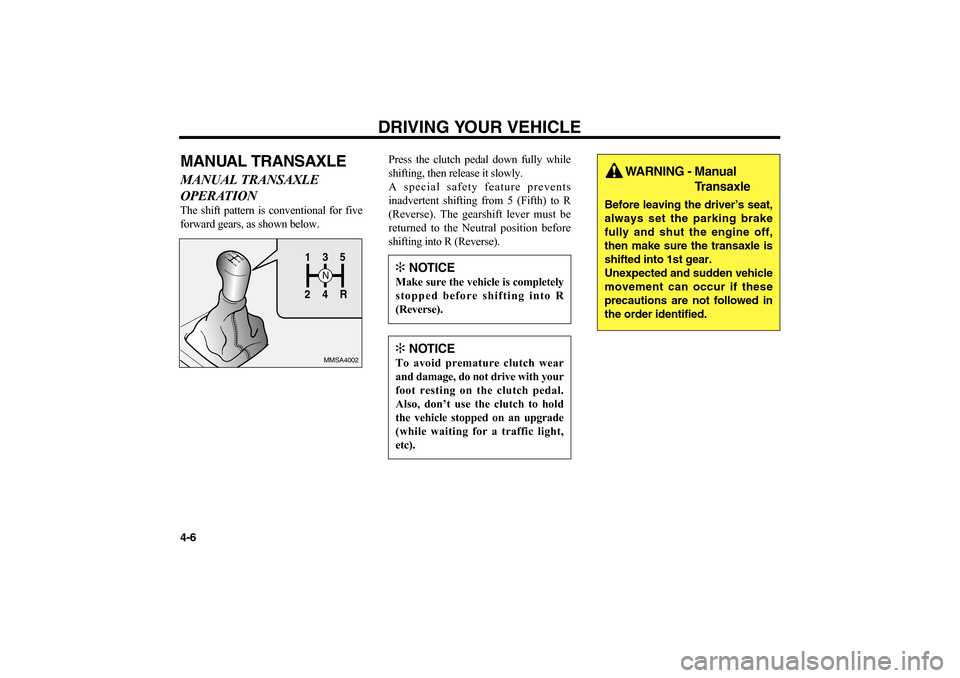
MANUAL TRANSAXLEMANUAL TRANSAXLE
OPERATIONThe shift pattern is conventional for five
forward gears, as shown below.Press the clutch pedal down fully while
shifting, then release it slowly.
A special safety feature prevents
inadvertent shifting from 5 (Fifth) to R
(Reverse). The gearshift lever must be
returned to the Neutral position before
shifting into R (Reverse).
DRIVING YOUR VEHICLE
4-6
1
24
R 3
S
N
135
R 4 2
MMSA4002
✻
NOTICE
Make sure the vehicle is completely
stopped before shifting into R
(Reverse).✻
NOTICE
To avoid premature clutch wear
and damage, do not drive with your
foot resting on the clutch pedal.
Also, don’t use the clutch to hold
the vehicle stopped on an upgrade
(while waiting for a traffic light,
etc).
WARNING - Manual
Transaxle
Before leaving the driver’s seat,
always set the parking brake
fully and shut the engine off,
then make sure the transaxle is
shifted into 1st gear.
Unexpected and sudden vehicle
movement can occur if these
precautions are not followed in
the order identified.
MS-CNA-Eng 4(~39).QXD 7/25/2005 5:16 PM Page 6
Page 86 of 225
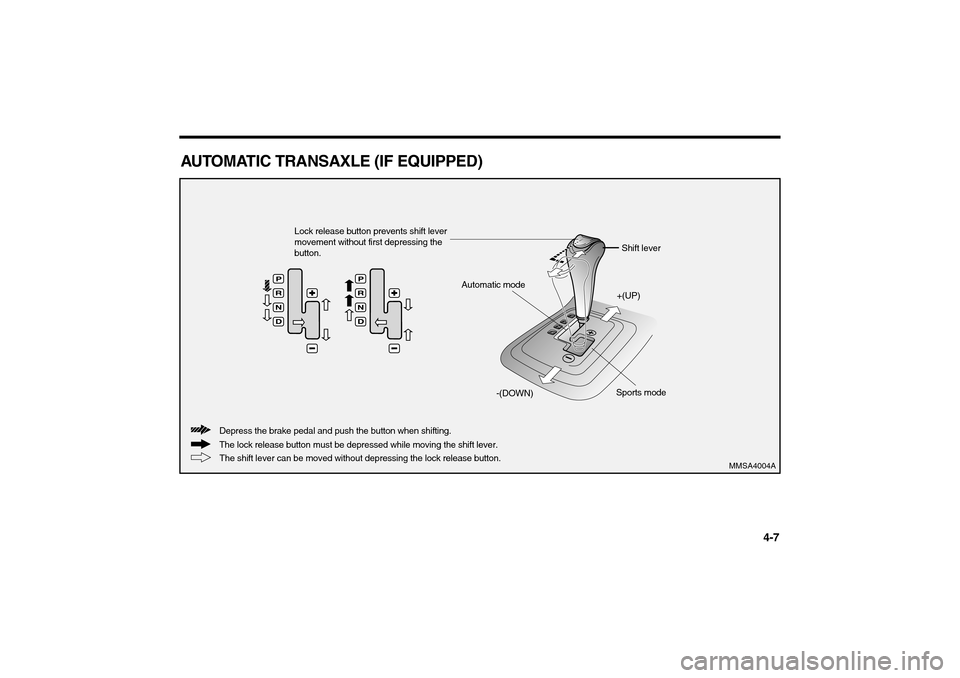
4-7
AUTOMATIC TRANSAXLE (IF EQUIPPED)
PRND
The lock release button must be depressed while moving the shift lever. Depress the brake pedal and push the button when shifting.Lock release button prevents shift lever
movement without first depressing the
button.
The shift lever can be moved without depressing the lock release button.
MMSA4004A
Shift lever
Automatic mode
+(UP)
-(DOWN)Sports mode
MS-CNA-Eng 4(~39).QXD 7/25/2005 5:16 PM Page 7
Page 87 of 225

AUTOMATIC TRANSAXLE
OPERATIONAll normal forward driving is done with
the shift lever in the D (Drive) position.
To move the shift lever from the P (Park)
position, the ignition switch must be in
the ON position, the brake pedal must be
depressed, and the lock release button
must be depressed.
For smooth operation, depress the brake
pedal when shifting from N (Neutral) to
a forward or Reverse gear.
DRIVING YOUR VEHICLE
4-8
CAUTION
• Do not accelerate the engine in R
(Reverse) or any of the forward
positions with the brakes on.
When stopped on an upgrade,
do not hold the vehicle station-
ary with engine power. Use the
service brake or the parking
brake.
Do not shift from N (Neutral) or
P (Park) into D (Drive) or R
(Reverse) when the engine is
above idle speed.
WARNING - Automatic
Transaxle
Before leaving the driver’s seat,
always make sure the shift
lever is in the P (park) position;
then set the parking brake fully
and shut the engine off.
Unexpected and sudden vehicle
movement can occur if these
precautions are not followed in
the order identified.
MS-CNA-Eng 4(~39).QXD 7/25/2005 5:16 PM Page 8
Page 88 of 225
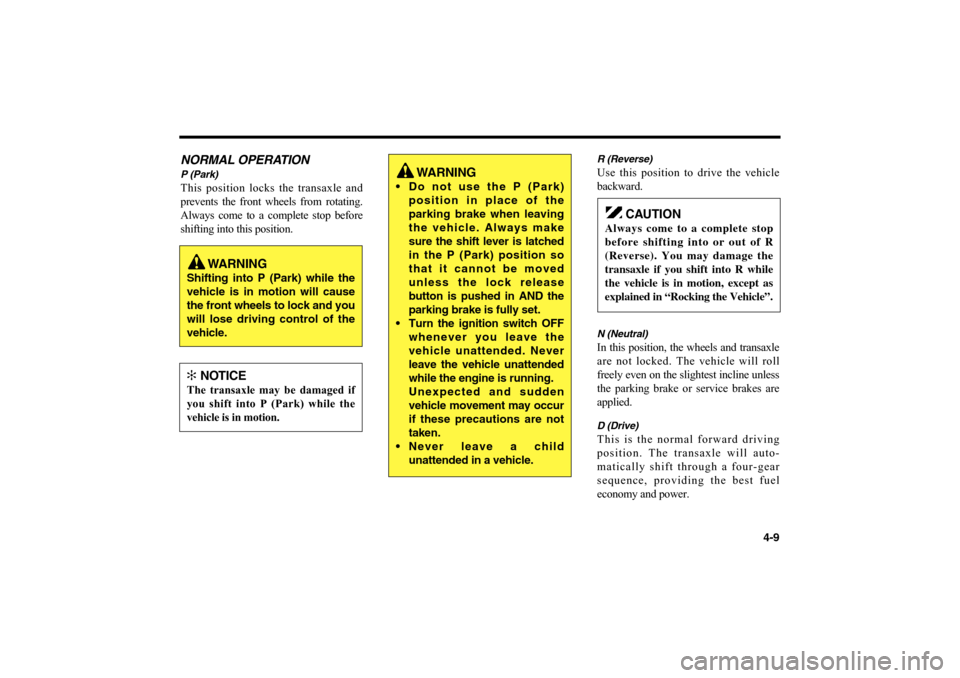
NORMAL OPERATIONP (Park)This position locks the transaxle and
prevents the front wheels from rotating.
Always come to a complete stop before
shifting into this position.
R (Reverse)Use this position to drive the vehicle
backward.N (Neutral)In this position, the wheels and transaxle
are not locked. The vehicle will roll
freely even on the slightest incline unless
the parking brake or service brakes are
applied.D (Drive)This is the normal forward driving
position. The transaxle will auto-
matically shift through a four-gear
sequence, providing the best fuel
economy and power.
4-9
WARNING
Shifting into P (Park) while the
vehicle is in motion will cause
the front wheels to lock and you
will lose driving control of the
vehicle.✻
NOTICE
The transaxle may be damaged if
you shift into P (Park) while the
vehicle is in motion.
WARNING
Do not use the P (Park)
position in place of the
parking brake when leaving
the vehicle. Always make
sure the shift lever is latched
in the P (Park) position so
that it cannot be moved
unless the lock release
button is pushed in AND the
parking brake is fully set.
Turn the ignition switch OFF
whenever you leave the
vehicle unattended. Never
leave the vehicle unattended
while the engine is running.
Unexpected and sudden
vehicle movement may occur
if these precautions are not
taken.
Never leave a child
unattended in a vehicle.
CAUTION
Always come to a complete stop
before shifting into or out of R
(Reverse). You may damage the
transaxle if you shift into R while
the vehicle is in motion, except as
explained in “Rocking the Vehicle”.
MS-CNA-Eng 4(~39).QXD 7/25/2005 5:16 PM Page 9
Page 89 of 225
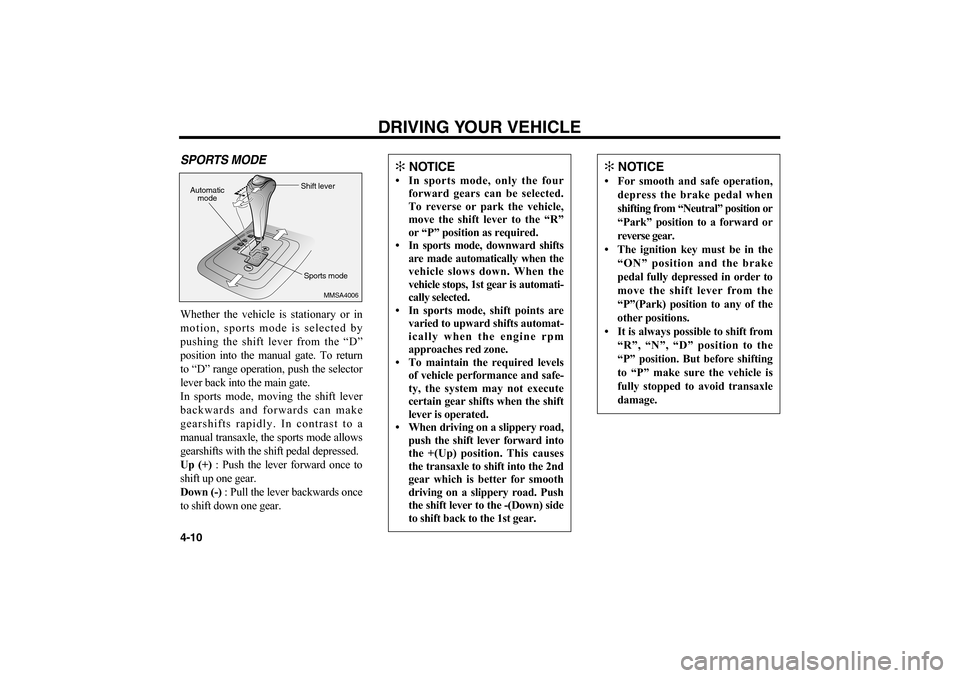
SPORTS MODEWhether the vehicle is stationary or in
motion, sports mode is selected by
pushing the shift lever from the “D”
position into the manual gate. To return
to “D” range operation, push the selector
lever back into the main gate.
In sports mode, moving the shift lever
backwards and forwards can make
gearshifts rapidly. In contrast to a
manual transaxle, the sports mode allows
gearshifts with the shift pedal depressed.
Up (+): Push the lever forward once to
shift up one gear.
Down (-): Pull the lever backwards once
to shift down one gear.
DRIVING YOUR VEHICLE
4-10
PRND
MMSA4006
Automatic
modeShift lever
Sports mode
✻
NOTICE
• In sports mode, only the four
forward gears can be selected.
To reverse or park the vehicle,
move the shift lever to the “R”
or “P” position as required.
• In sports mode, downward shifts
are made automatically when the
vehicle slows down. When the
vehicle stops, 1st gear is automati-
cally selected.
• In sports mode, shift points are
varied to upward shifts automat-
ically when the engine rpm
approaches red zone.
• To maintain the required levels
of vehicle performance and safe-
ty, the system may not execute
certain gear shifts when the shift
lever is operated.
• When driving on a slippery road,
push the shift lever forward into
the +(Up) position. This causes
the transaxle to shift into the 2nd
gear which is better for smooth
driving on a slippery road. Push
the shift lever to the -(Down) side
to shift back to the 1st gear.
✻
NOTICE
• For smooth and safe operation,
depress the brake pedal when
shifting from “Neutral” position or
“Park” position to a forward or
reverse gear.
• The ignition key must be in the
“ON” position and the brake
pedal fully depressed in order to
move the shift lever from the
“P”(Park) position to any of the
other positions.
• It is always possible to shift from
“R”, “N”, “D” position to the
“P” position. But before shifting
to “P” make sure the vehicle is
fully stopped to avoid transaxle
damage.
MS-CNA-Eng 4(~39).QXD 7/25/2005 5:16 PM Page 10
Page 90 of 225
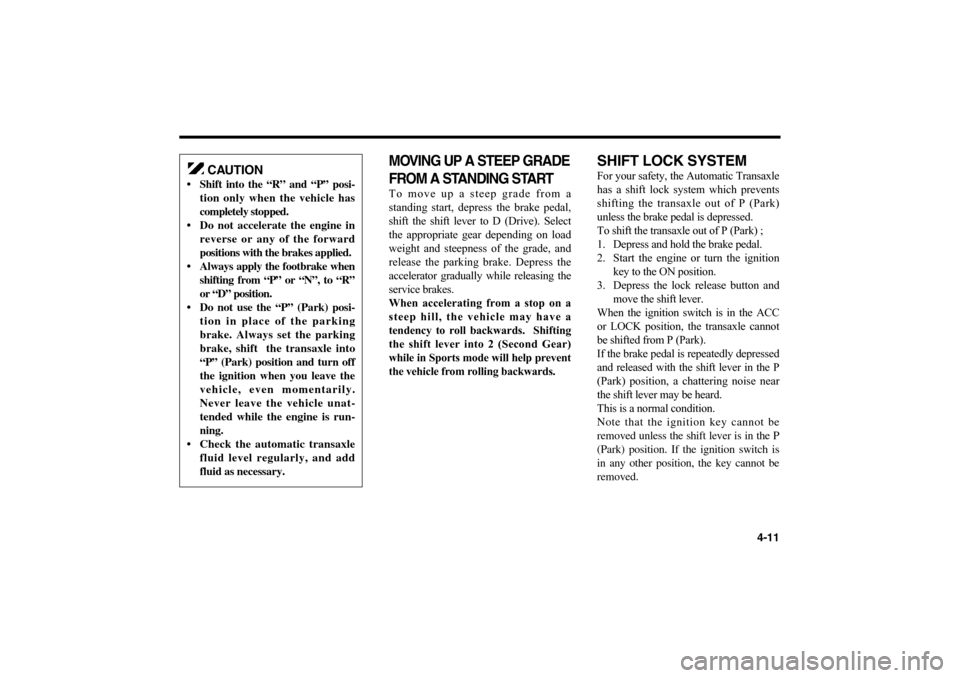
MOVING UP A STEEP GRADE
FROM A STANDING STARTTo move up a steep grade from a
standing start, depress the brake pedal,
shift the shift lever to D (Drive). Select
the appropriate gear depending on load
weight and steepness of the grade, and
release the parking brake. Depress the
accelerator gradually while releasing the
service brakes.
When accelerating from a stop on a
steep hill, the vehicle may have a
tendency to roll backwards. Shifting
the shift lever into 2 (Second Gear)
while in Sports mode will help prevent
the vehicle from rolling backwards.
SHIFT LOCK SYSTEMFor your safety, the Automatic Transaxle
has a shift lock system which prevents
shifting the transaxle out of P (Park)
unless the brake pedal is depressed.
To shift the transaxle out of P (Park) ;
1. Depress and hold the brake pedal.
2. Start the engine or turn the ignition
key to the ON position.
3. Depress the lock release button and
move the shift lever.
When the ignition switch is in the ACC
or LOCK position, the transaxle cannot
be shifted from P (Park).
If the brake pedal is repeatedly depressed
and released with the shift lever in the P
(Park) position, a chattering noise near
the shift lever may be heard.
This is a normal condition.
Note that the ignition key cannot be
removed unless the shift lever is in the P
(Park) position. If the ignition switch is
in any other position, the key cannot be
removed.
4-11
CAUTION
Shift into the “R” and “P” posi-
tion only when the vehicle has
completely stopped.
Do not accelerate the engine in
reverse or any of the forward
positions with the brakes applied.
Always apply the footbrake when
shifting from “P” or “N”, to “R”
or “D” position.
Do not use the “P” (Park) posi-
tion in place of the parking
brake. Always set the parking
brake, shift the transaxle into
“P” (Park) position and turn off
the ignition when you leave the
vehicle, even momentarily.
Never leave the vehicle unat-
tended while the engine is run-
ning.
Check the automatic transaxle
fluid level regularly, and add
fluid as necessary.
MS-CNA-Eng 4(~39).QXD 7/25/2005 5:16 PM Page 11